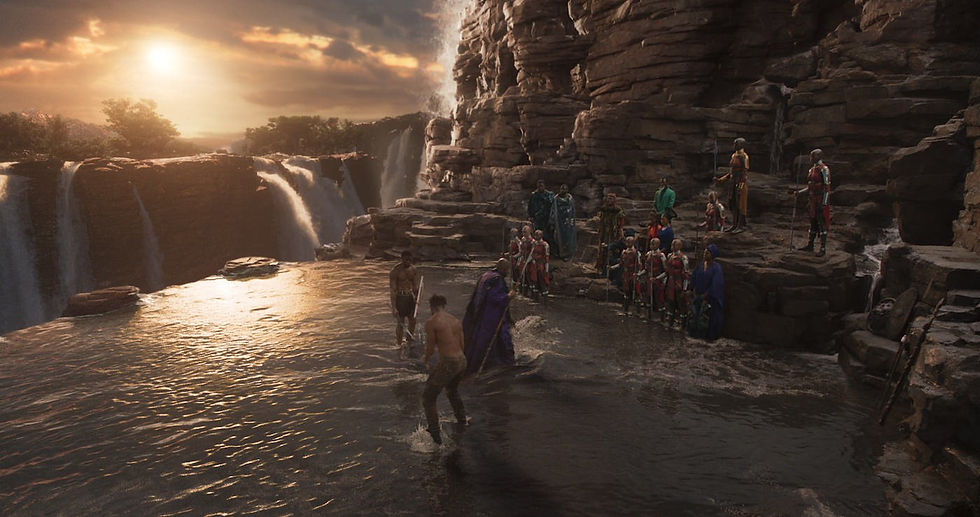Framing techniques that will make you a better filmmaker
- Amanda Nuir Myrdal

- Jan 8, 2019
- 3 min read
Updated: Mar 26, 2020
To effectively develop a cinematic experience consider the framing within the scene of the narrative. Before filming, the production team creates a list of shots. This shot list expresses strategies that visually communicate the framing, lighting and audio of the scene. Consider the emotional response of the audience. How do you want the viewers to react? Follow these steps to instantly improve the cinematic experience of your movie.
Framing
A. Establishing shot (ES)
B. High Angle Shot (HS)
C. Wide Shot (WS) E. Medium Shot (MS)
G. Close Up (CU)
H. Extreme Close Up (ECU)
A. Establishing shot (ES)
An establishing shot is at the beginning of a scene. It clearly shows the location and surroundings of the subject within the scene. This shot is often an exterior in order to show the environment.

Establishing shot (ES), Captain America: The First Avenger

Establishing shot (ES), Do the Right Thing

Establishing shot (ES), Avengers: Infinity War
An establishing shot can also help express the time of day within the scene.

Establishing shot (ES), Harry Potter and the Sorcerer's Stone

Establishing shot (ES), Black Panther

Extreme wide shot + high angle (EWS+HS), The Revenant
B. High Angle Shot (HS)
A high angle shot is used to make the subject feel vulnerable compared to the world around them .

High angle shot (HS) , Harry Potter and the Deathly Hallows

High angle shot (HS), The Avengers

High angle shot (HS), Moonrise Kingdom

High angle shot (HS), The Lord of the Rings: The Fellowship of the Ring
C. Wide Shot (WS)
The wide shot keeps the entire body in the frame. In other words, there should be space above and below the subject. Similar to the establishing shot, the wide shot emphasizes location and environment of subject within the scene.

Wide shot (WS), Road to Perdition

Wide shot (WS), Thor

Wide shot (WS), Pirates of the Caribbean: Dead Men Tell No Tales

Wide shot (WS), Thor: Ragnarok

Wide shot (WS), Suicide Squad
If framed in a low angle shot (i.e. looking up from the ground) you can make a formidable villain.

Medium wide shot + low angle (MWS+LA), The Dark Knight
E. Medium Shot (MS)
The medium shot reveals your subject in more detail and frames from roughly the waist up. The medium shot differs from the medium wide shot by focusing on the character rather than environment.

Medium shot (MS), Social Network

Medium shot (MS), Dark Knight Rises

Medium shot (MS), Sherlock

Medium over-the-shoulder shot (MS+OS), Fight Club

Medium shot (MS), The Matrix

Medium shot (MS) , The King’s Speech
F. Medium Close Up (MCU)
The medium close-up frames your subject from roughly the chest up. The MCU focuses on the subject's emotional response to their environment.

Medium close up (MCU), The Big Lebowski

Medium close up (MCU), The Big Lebowski

Medium close up (MCU), O Brother, Where Art Thou?

Medium (MS), A Beautiful Mind

Medium close up (MCU), The Searchers
G. Close Up (CU)
The close up shot fills the frame with the subject and can reveal emotions, reactions and important details within the scene.

Close-up (CU) , The Girl with the Dragon Tattoo

Close-up (CU) , The Shining

Close-up (CU), The Dark Knight
H. Extreme Close Up (ECU)
An extreme close-up much like a close up can be used to emphasize important details and emotional reactions within the scene.

Extreme Close Up (ECU) , The Lord of the Rings: The Fellowship of the Ring

Extreme Close Up (ECU), X-Men: First Class

Extreme close up (ECU), Zodiac



Comments